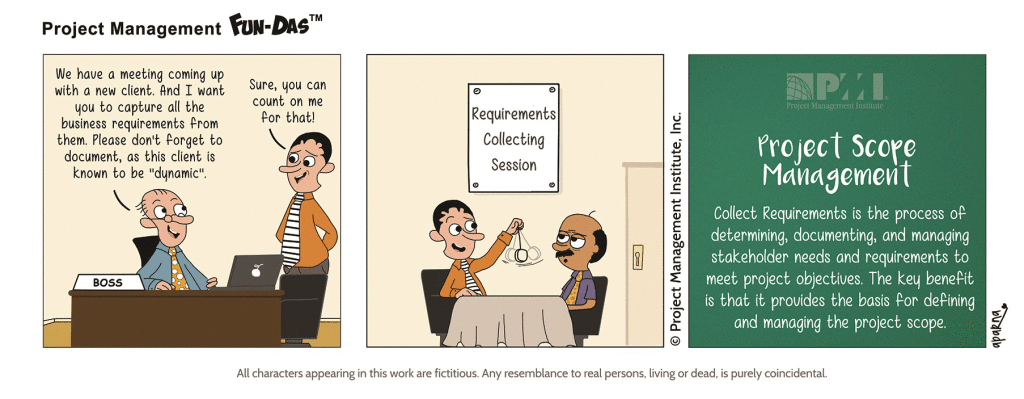Project Scope management consists of the process of defining the required work and making sure all the tasks are
competently completed on time. A scope management plan must include a thorough procedure of scope determination, supervision, and control. For this purpose, the project manager seeks endorsement on a well-defined and evidently articulated scope. To identify scope, all requirements must be collected from stakeholders. You may have two different opinions on the change management of the Scope. This depends on the methodology you are following; Adaptive, where the change is welcome or WaterFall, where changes are generally not welcome or at least not taken positively
This knowledge area deals with multiple types of Requirements;
- Business Requirement
- Stakeholder requirements
- Solution Requirements consists of Functional and Non-Functional Requirements
- Transitional Requirements
To make sure that you really have gotten a hold on the Project Scope, make sure that you cover
- Product Scope
- Product Acceptance Criteria
- Project Deliverables
- What is not Part of Scope
- Constraints and Assumptions
Project Scope Management Processes
There are six major elements in the process of scope management to achieve and outline the project’s parameters. These are:
Plan Scope Management
A scope management plan is developed based on the response from the project plan, the project charter, and discussion with stakeholders. It involves:
- Establishing explicit and realistic objectives
- Evaluate from time to time if objectives are being met
- Take counteractive actions
Collect Requirements
The process of collecting requirements include verifying stakeholders needs to meet project purposes. It involves consultations, focus group deliberations, surveys, facilitated workshops, group inspiration techniques, questionnaires and reviews, observations and archetypes It results in
- Requirements documents
- Requirements traceability medium
- Requirements management plan
Define Scope
The define scope process refers to defining a detailed account of the project and key deliverables. A project scope statement is created based on all requirements documentation along with the project charter, and the scope management plan. The process involves an expert decision, product evaluation, substitute identification, and facilitated workshops.
Create WBS
A Work Breakdown Structure is created after evaluating the project scope statement and the requirements documentation. It’s the graphical representation of the hierarchy of the project. The WBS template can be used across multiple projects. It motivates the project team to deliberate through all the levels of the project. If a particular task is not in the WBS, then it’s probably not the part of the project.
Validate Scope
To validate scope, all deliverables are inspected and reviewed. They are either accepted or further revisions are requested. It’s the process in which the project customer officially accepts the project deliverables. Scope validation occurs by the end of each phase while in the process of validating scope, the customer gives feedback on work accomplished. It primarily emphasizes on customer acceptance and performs quality control process.
Control Scope
Once the project is executed, the scope must be controlled. Here performance reports are compared against project requirements to determine the existing gaps which may results in a modification to the project plan. The process involves monitoring the status of the project and managing scope changes.

Key Deliverables of Project Scope Management
Project Scope Statement**
An effective project scope statement includes a number of specific points. This should be used as an effective communication tool to provide a common understanding of the project scope among project stakeholders. These points include the following:
- Justification: explaining the need that your project is addressing.
- Product scope description: Project scope planning means that understanding and defining the scope is essential to do before beginning project work, including project and product scope
- Acceptance criteria: e specific conditions that need to be met before any project deliverables are excepted.
- Deliverables: The deliverables of a project are also known as the project objectives.
- Project Exclusions: It includes what will not be done as part of the project so that any uncertainties or assumptions are clarified fully for everyone involved.
- Limitations: Limitations refer to the restrictions placed on what is possible to achieve, the timeframe in which you achieve it and the cost of the achievements
- Assumptions: In the scope of business management, change is constant, and sometimes no matter how in-depth your planning process has been, your project and team could face some uncertainties. The project scope statement should outline the procedure you will follow in addressing any uncertain information throughout project work.
The project scope statement is the description of the project scope, major deliverables, assumptions, and constraints.
WBS & WBS dictionary
WBS, a graphical hierarchal representation of Project Deliverables. It provides a basis to many other processes like;
- Cost Estimation
- Cost Budgeting
- Scope control
- Activity Definition
- Plan Purchases and Acquisitions
The WBS Dictionary defines every component of the WBS with its milestones, deliverables, undertakings, and opportunities. It’s a project series that let you analyze your project data from many aspects. It can also provide you with dates, resources, budgets, and worth.
Requirement Traceability Matrix
RTM is the most important item in your arsenal as it starts early remains with you throughout the execution and ends with the transfer of deliverables sometimes with an operational transfer
Scope Baseline
Further Readings
- Project Management Office (PMO)
- Business Case
- The Project Manager and Business Analyst: A unique relationship
- Benefits Management Plan
- PROJECT SCOPE STATEMENT




